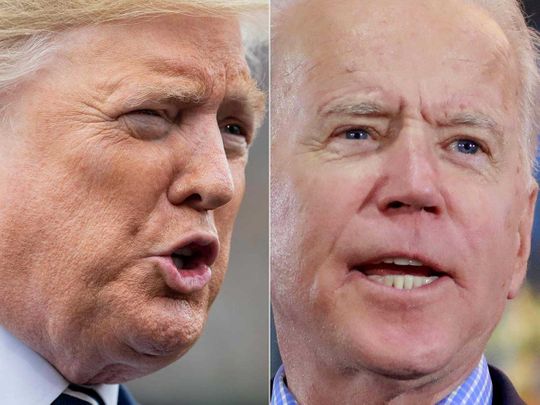
Washington: Joe Biden has taken a commanding lead over President Donald Trump in the 2020 race, building a wide advantage among women and non-white voters and making deep inroads with some traditionally Republican-leaning groups that have shifted away from Trump following his ineffective response to the coronavirus pandemic, according to a new national poll of registered voters by The New York Times and Siena College.
Biden is currently ahead of Trump by 14 percentage points, garnering 50% of the vote compared with 36% for Trump. That is among the most dismal showings of Trump’s presidency, and a sign that he is the clear underdog right now in his fight for a second term.
Trump has been an unpopular president for virtually his entire time in office. He has made few efforts since his election in 2016 to broaden his support beyond the right-wing base that vaulted him into office with only 46% of the popular vote and a modest victory in the Electoral College.
But among a striking cross-section of voters, the distaste for Trump has deepened as his administration failed to stop a deadly disease that crippled the economy and then as he responded to a wave of racial-justice protests with angry bluster and militaristic threats. The dominant picture that emerges from the poll is of a country ready to reject a president whom a strong majority of voters regard as failing the greatest tests confronting his administration.
Male voters
Biden leads Trump by enormous margins with black and Hispanic voters, and women and young people appear on track to choose Biden by an even wider margin than they favoured Hillary Clinton over Trump in 2016. But the former vice-president has also drawn even with Trump among male voters, whites and people in middle age and older - groups that have typically been the backbones of Republican electoral success, including Trump’s in 2016.
Arlene Myles, 75, of Denver, said she had been a Republican for nearly six decades before switching her registration to independent earlier this year during Trump’s impeachment trial. Myles said that when Trump was first elected, she had resolved to “give him a chance,” but had since concluded that he and his party were irredeemable.
“I was one of those people who stuck by Nixon until he was waving goodbye,” Myles said. “I thought I was a good Republican and thought they had my values, but they have gone down the tubes these last few years.”
Myles said she planned to vote for Biden, expressing only one misgiving: “I wish he was younger,” she said.
Advantage
Most stark may be Biden’s towering advantage among white women with college degrees, who support him over Trump by 39 percentage points. In 2016, exit polls found that group preferred Clinton to Trump by just 7 percentage points. The poll also found that Biden has narrowed Trump’s advantage with less-educated white voters.
The exodus of white voters from the GOP has been especially pronounced among younger voters, an ominous trend for a party that was already heavily reliant on older Americans.
Fifty-two percent of whites under 45 said they supported Biden while only 30% said they supported Trump. And their opposition is intense: More than twice as many younger whites viewed the president very unfavorably than very favourably.
Tom Diamond, 31, a Republican in Fort Worth, Texas, said he planned to vote for Trump but would do so with real misgivings. He called the president a “poor leader” who had mishandled the pandemic and said Biden seemed “like a guy you can trust.” But Trump held views closer to his own on the economy, health care and abortion.
Racial attitudes
Some unease toward Trump stems from voters’ racial attitudes. According to the poll, white voters under 45 are overwhelmingly supportive of the Black Lives Matter movement, while older whites are more tepid in their views toward racial justice activism. And nearly 70% of whites under 45 said they believed the killing of George Floyd was part of a broader pattern of excessive police violence toward African Americans rather than an isolated incident.
What’s striking, though, is that even among white seniors, one of Trump’s strongest constituencies, he has damaged himself with his conduct. About two-fifths of whites over 65 said they disapproved of Trump’s handling of both the coronavirus and race relations.
Trump retains a few points of strength in the poll that could offer him a way to regain a footing in the race, and the feeble condition of his candidacy right now may well represent his low point in a campaign with 4 1/2 months still to go.
His approval rating is still narrowly positive on the issue of the economy, with 50% of voters giving him favourable marks compared with 45% saying the opposite. Should the fall campaign become a referendum on which candidate is better equipped to restore prosperity after the pandemic has subsided, that could give Trump a new opening to press his case.
The president is also still ahead of Biden among white voters without college degrees, who hold disproportionate influence in presidential elections because of how central the Midwest is to capturing 270 electoral votes.
Yet if Trump still has a significant measure of credibility with voters on the economy, he lacks any apparent political strength on the most urgent issues of the moment: the pandemic and the national reckoning on policing and race.
Nearly three-fifths of voters disapprove of Trump’s handling of the coronavirus pandemic, including majorities of white voters and men. Self-described moderate voters disapproved of Trump on the coronavirus by a margin of more than 2-1.
Most of the country is also rejecting Trump’s call to reopen the economy as quickly as possible, even at the cost of exposing people to greater health risks. By a 21-point margin, voters said the federal government should prioritise containing the coronavirus, even if it hurts the economy, a view that aligns them with Biden.
Race relations
Trump’s job approval on race relations was just as dismal. Sixty-one percent of voters said they disapproved of Trump’s handling of race, versus 33% who said they approved. By a similar margin, voters said they disapproved of his response to the protests after the death of Floyd.
Trump has sought several times in the last month to use demonstrations against the police as a political wedge issue, forcing Democrats to align themselves squarely either with law-enforcement agencies or with the most strident anti-police demonstrators.
The poll suggested most voters were rejecting that binary choice, as well as Trump’s harsh characterisation of protesters: Large majorities said they had a positive overall assessment of both the Black Lives Matter movement and the police.
The picture of Biden that emerges from the poll is one of a broadly acceptable candidate who inspires relatively few strong feelings in either direction. He is seen favourably by about half of voters and unfavorably by 42%. Only a quarter said they saw him very favorably, equaling the share that sees him in very negative terms.
Trump, by contrast, is seen very favourably by 27% of voters and very unfavorably by 50%.








